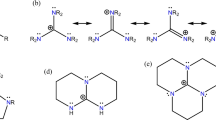Abstract
2,3-Trimethylene-3,4-dihydroquinazoline shares the heterocyclic core with natural compounds and synthetic drugs. The hydrochloride of the compound forms excellent dihydrate crystals which have allowed us to collect high-resolution X-ray diffraction data and obtain the experimental charge density. The solid may be understood as built up from pairs of heterocyclic cations and chloride anions; a direct hydrogen bond links the halide to the formally cationic pyrimidine NH group. The hydrate water molecules interact with the anions, forming an infinite chain along the crystallographic a axis between the stacks of the heterocyclic cations. Based on the experimental charge density, a dipole moment of 16.1 Debye is calculated for a pair of the hydrogen-bonded quinazolinium cation and the chloride anion in the extended crystal structure.
Similar content being viewed by others
References
S. Johne, Pharmazie, 36, 583 (1981).
M. V. Telezhenetskaya and S. Yu. Yunusov, Chem. Natur. Comp., 13, No. 6, 731 (1977).
S. Yu. Yunusov, N. Tulyaganov, M. V. Telezhenetskaya, et al., USSR Patent No. 605614, Anticholinesterase Agent, Byull. Izobret. (Russ.) (1978), p. 17.
C. S. Harris, L. Hennequin, R. Morgentin, et al., Targets in Heterocyclic Systems, 14, 315 (2010).
P. Coppens, X-Ray Charge Densities and Chemical Bonding, Oxford University Press, New York (1997).
S. Mebs, A. Lueth, W. Loewe, et al., Zeitschrift für Kristallographie, 223, No. 8, 502 (2008).
T. Khaliq, P. Misra, S. Gupta, et al., Bioorg. Med. Chem. Lett., 19, No. 9, 2585 (2009).
Kh. N. Khashimov, M. V. Telezhenetskaya, and S. Yu. Yunusov, Chem. Natur. Comp., 5, No. 5, 456 (1969).
Kh. M. Shakhidoyatov, A. Irisbaev, L. M. Yun, et al., Chem. Heterocycl. Comp., 12, No. 11, 1286 (1976).
Kh. M. Shakhidoyatov and I. K. Kaisarov, Chem. Natur. Comp., 34, No. 1, 59 (1998).
K. C. Jahng, S. I. Kim, D. H. Kim, et al., Chem. Pharm. Bull., 56, No. 4, 607 (2008).
A. Al-Shamma, S. Drake, D. L. Flynn, et al., J. Nat. Prod., 44, No. 6, 745 (1981).
A. G. Tojiboev, K. K. Turgunov, B. Tashkhodjaev, et al., Chem. Natur. Comp., 42, No. 3, 280 (2006).
B. Tashkhodzhaev, L. V. Molchanov, K. K. Turgunov, et al., Chem. Natur. Comp., 31, No. 3, 421 (1995).
N. K. Hansen and P. Coppens, Acta Crystallogr. Sect. A, 34, 909 (1978).
SMART and SAINT, Bruker AXS Inc., Madison, Wisconsin, USA (1999).
SADABS: Program for Empirical Absorption Correction of Area Detector Data, V 2004/1, Bruker AXS Inc., Madison, WI, USA (2004).
G. M. Sheldrick, Acta Crystallogr. Sect. A, 64, 112 (2008).
H. D. Flack, Acta Crystallogr. Sect. A, 39, No. 6, 876 (1983).
A. Volkov et al., XD2006, Univ. New York at Buffalo, USA (2006).
F. L. Hirshfeld, Acta Crystallogr. Sect. A, 32, No. 2, 239 (1976).
M. J. Frisch et al., Gaussian 09, Revision A-02, Gaussian, Inc., Wallingfort CT, USA (2009).
T. H. Dunning, J. Chem. Phys., 90, No. 2, 1007 (1989).
A. L. Spek, Acta Crystallogr. Sect. D, 65, No. 2, 148 (2009).
R. F. W. Bader, Atoms in Molecules a Quantum Theory, Clarendon Press, Oxford (1990).
M. Serb, R. Wang, M. Meven, et al., Acta Crystallogr. Sect. B, 67, No. 6, 552 (2011).
P. Gilli, V. Bertolasi, V. Ferretti, et al., J. Am. Chem. Soc., 116, No. 3, 909 (1994).
C. B. Hübschle and B. Dittrich, J. Appl. Crystallogr., 44, No. 1, 238 (2011).
M. Mladenovic, M. Arnone, and R. F. Fink, J. Phys. Chem., 113, No. 15, 5072 (2009).
Author information
Authors and Affiliations
Corresponding author
Additional information
Original Russian Text © 2013 A. Tojiboev, R. Wang, F. Pan, U. Englert, K. Turgunov, R. Okmanov
The text was submitted by the authors in English. Zhurnal Strukturnoi Khimii, Vol. 54, No. 6, pp. 980–985, November–December, 2013.
Rights and permissions
About this article
Cite this article
Tojiboev, A., Wang, R., Pan, F. et al. Insight into the chemical bonding and electrostatic potential: A charge density study on a quinazoline derivative. J Struct Chem 54, 1012–1017 (2013). https://doi.org/10.1134/S0022476613060036
Received:
Revised:
Published:
Issue Date:
DOI: https://doi.org/10.1134/S0022476613060036



